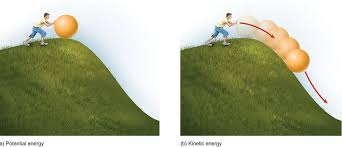Resetting vs. Touch & Go
by Erik Castiglione
In our current strength cycle, we’ve been doing deadlifts as speed pulls, where we encourage members to reset on each rep. And for our upper body volume days, we’ve been doing the strict barbell press, and encouraging members to touch and go. There’s been a little confusion, because there are days where we encourage members to reset for each strict press, and touch and go for deadlifts. What’s the difference between the two, and why do we mix it up?
To answer this properly, I have to unfortunately ask you to recall some basic physics. Specifically, we need to review potential energy. The definition of potential energy is “the energy possessed by a body by virtue of its position relative to others, stresses within itself, electric charge, and other factors.” Some easy examples: a ball at the top of a hill, and a stretched elastic band both have potential energy. Keep these examples in the back of your mind.
Next, we need to differentiate the deadlift from a squat, and the strict press from a bench press. In both the squat and the bench press, the athlete starts with the bar at the top of the movement. The athlete lowers the bar to the bottom position, and then raises it back up. The lowering phase is called the eccentric portion of the lift, and the raising phase is the concentric portion of the lift. In the deadlift and the strict press, the athlete starts with the bar at the bottom of the movement, and must raise it to the top. Both of these movements begin with the concentric portion of the lift, rather than the eccentric.
`
When we start with the bar at the top of a lift, the bar has great potential energy, similar to a ball at the top of a hill. When we perform the eccentric portion of a lift, that potential energy is transferred and stored in our tendons and connective tissues, similar to a rubber band that is stretched. This makes it easier to perform the concentric portion, because we have stored energy we can use to help generate force, along with our muscles. We don’t have this help in lifts that begin with the concentric portion. So, when we perform the deadlift and strict press and reset each rep, we are letting the stored potential energy escape, and only using our muscles to generate force. When we touch and go after the first rep, we are now using the potential energy from the eccentric part of the lift, making subsequent reps easier than the first.
Okay, now that the science is out of the way and you hopefully understand the difference between the two methods of lifting, why do we choose one over the other? Well, each method trains something a little different, so it depends on the goal of the day. When we’re training speed, or near max effort work, we’re trying to improve your ability to generate as much force as possible in the shortest amount of time – in other words, we’re improving your power. And we can measure this by testing your 1 rep max, which, as we’ve already discussed, starts with the concentric part of the lift for the deadlift and strict press. Learning to engage while at rest to generate the maximum force you can is a skill in and of itself, so we need to practice it. We do this by resetting on each rep, and we save this method for speed and heavy days. Force equals mass x acceleration – we use high mass on heavy days, and high acceleration on speed days. And the rep schemes these days are small enough that we can repeat the reset without too much fatigue.
On volume days, we’re training your muscular stamina, and hopefully building a little muscle as well. Time under tension, or the amount of time spent contracting under load, is an important factor in this. When we do bigger sets and use touch and go reps, we spend more time under tension. Resetting releases that tension, which is counter productive to our goals in this case. So, we do encourage touch and go in our strength work, it just depends on the training goal for that particular day.
In metcons, touch and go reps are generally faster, because you take the set-up time out of the equation. But, as we mentioned, they train muscular stamina, which means that they’re going to fatigue your muscles more quickly. Furthermore, the more time you spend under tension, the bigger spike you’re going to feel in your heart rate and breathing. So, even though touch and go is faster, it will tax you more. Once again, depending on the goal of the metcon, this may be the way to go, or, you may want to break up your sets. In general, it all comes down to the goal of that particular workout, whether it’s strength work, or a metcon.
So, we perform both touch and go reps, and reps where we reset each time. Both methods serve a purpose, so which method we use on a given day depends on that day’s training goal. See you in the gym


